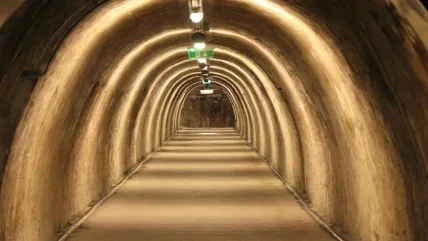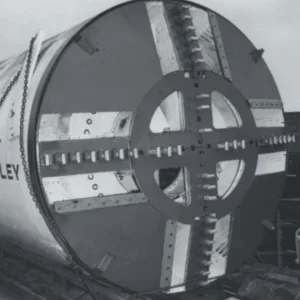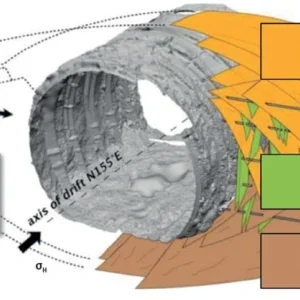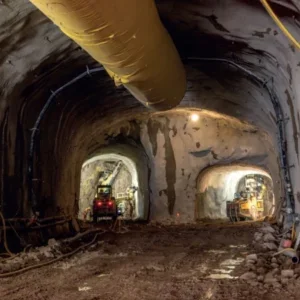
The theme of WTC 2023 is Expanding Underground and the host city, Athens, has a long history with tunnels. The Greek capital aims to add metro extensions to the city’s transport work that will increase the previous total of 75 stations by almost half again.
Recently, the Line 3 extension project was completed as 7.6km-long twin tunnel to Piraeus, including six new stations toward the increased total. The metro owner, Attiko Metro S.A, has work underway on Line 4. The Phase 1 section is totally in tunnel between Alsos Veikou and Goudi.
Beyond Athens, other tunnel projects has included works for Thessaloniki metro, which has been under development for years and includes 18 underground stations and required 14.4km of tunnelling; a total of 13km of road tunnels for the Northern Road Axis concession, on Crete; and, a 1.2km-long subsea road tunnel from Lefkada island to the mainland.
With much achieved over centuries and with a view to examining what may come ahead, ITA President, Prof Arnold Dix, and Greek Tunnelling Society (GTS) President, Nikolaos Roussos, took some questions from ITA and they shared their answers and discussion on challenges for tunnelling and what the WTC 2023 Conference offers delegates from across the world.
WHAT IS THE STATE OF THE TUNNELLING SECTOR GLOBALLY AND PARTICULARLY IN GREECE?
Arnold Dix (AD): Globally this sector has never been busier with major infrastructure being delivered as part of economic stimulus packages in many countries. Also the role of underground infrastructure in adaptive and resilient responses for the challenges posed by the changing climate has seen a boom in flood diversion, hydro power, sewerage and mountain transportation projects.
Nikolaos Roussos (NR): We see this trend here in Greece and in Athens. Its underground network has expanded considerably in recent years and this development is now accelerating significantly. The metro Line 3 extension project to Piraeus was successfully finished in October 2022, with the public opening of the final three new stations, Maniatika, Piraeus, and Dimotiko Theatro. The project, which included a 7.6 km long twin-track running tunnel, six new modern stations, and seven ventilation shafts, is one of the most significant expansions for the greater area of Athens and Piraeus region in decades.
A MAJOR PLAN FOR THE EXTENSION OF THE METRO NETWORK IN ATHENS IS UNDER DISCUSSION. WHY ARE THESE PROJECTS ESSENTIAL?
NR: At this time, in Athens, a metro network with over 110 stations is proposed, with 35 new stations in nine extensions. After a decade of focusing metro projects on the extension of Line 3 in Piraeus and the effort to begin the implementation of Line 4, new goals appear to be established for the coming years. The goal is to connect with other means, expand the network, and create new growth poles in the city, making Athens a friendlier city to its citizens and visitors.
Major plans for the extension of metro networks in big cities are essential for improving transportation, reducing congestion, promoting economic development, and enhancing urban mobility. These projects can have a significant positive impact on the lives of people in the city, making them a crucial investment for the future.
WHAT’S YOUR VIEW ABOUT SUSTAINABILITY IN TUNNELLING AND RESILIENCE AGAINST CLIMATE CHANGE? DOES THE SCARCITY OF URBAN SPACE RESOURCES MAKE THE UNDERGROUND SPACE PLANNING DE FACTO MORE SUSTAINABLE?
AD: The threats posed to urban environments like climate change, tend to relate to less reliable surface assets like roads, railways, power distribution, and surface drainage, because more frequent, higher intensity storm events and more severe weather (such as heat or cold), tend to damage and render existing surface infrastructure compromised.
This, then, raises the prospect of more adaptive infrastructure of which the underground delivers many unique opportunities. The sustainability of such options depends partly upon the consequences of building and operating them on the climate emergency itself. Enormous improvements have been made to the environmental implications of building such infrastructure, including low carbon materials and techniques.
In parallel, sustainability will be at the heart of the Plenary session on 16 May with three round tables: Building resilient infrastructures; Tunnels: part of the resilience; and, Planning the Future.
NR: Tunnelling can help reduce the environmental impact of transportation by providing underground mass transit systems, which can reduce the need for individual cars and improve air quality. Additionally, tunnels can be used to provide underground utility corridors, which can reduce the need for overhead transmission lines and help protect against extreme weather events.
Moreover, tunnels can provide additional space for sustainable infrastructure, such as underground water storage and renewable energy production.
Regarding the scarcity of urban space resources, yes, planning for the use of underground space can be considered more sustainable due to the limited availability of above-ground space in urban areas.
By utilising the underground space for transportation, utility corridors, and other infrastructure needs, it can help reduce the demand for above-ground space, which can help preserve green space and improve the overall liveability of urban areas. Tunnelling can play an important role in promoting sustainability and resilience in the built environment, and the scarcity of urban space resources makes underground space planning an attractive option for meeting infrastructure needs. However, it is important to balance the potential benefits of underground development with the need for responsible planning and management to ensure that it is sustainable and does not have negative impacts on the environment or surrounding communities.
PRECISELY, THE WTC 2023 WILL BE UNDER THE SIGN OF “EXPANDING UNDERGROUND”. IS THE UNDERGROUND SPACE UNDERVALUED AS AN ASSET?
NR: There is a significant amount that can be done below the surface of our cities, and the underground space is often undervalued as an asset. There are several reasons to explain that. Firstly, there is a lack of awareness and understanding of the potential uses and benefits of underground space. Many people may not realise that the underground space can be used for more than just transportation tunnels and utility tunnels.
Secondly, there are technical and logistical challenges associated with developing underground space. Excavating and constructing underground structures can be complex and costly, and requires specialised knowledge and equipment.
Thirdly, there may be regulatory and legal barriers to developing underground space. For example, there may be restrictions on the use of underground space in certain areas or limitations on the height or depth of structures that can be built.
AD: The area under cities is a spatial resource that is dimensionally limited but usually underutilised and undervalued.
There are enormous opportunities under most cities to augment the surface for greater human enjoyment and to deliver efficient and effective transportation, water, sewerage, energy, dangerous or confidential endeavours, strategic activities, and other complex human endeavours underground.
NR: There is a significant potential for development below the surface of our cities, and the underground space is often undervalued as an asset. By overcoming technical, logistical, and regulatory challenges, it is possible to unlock the full potential of the underground space and create new opportunities for urban development and growth. In our time, the urban planning of the underground space is mandatory for its optimum usage.
It is our duty (and pleasure!) as tunnel engineers to inform the public for the many and so diverse advantages of underground works. And this is what we try to do every day. To open a window for new opportunities below ground, that can make our lives so much better.
HOW CAN INNOVATIONS IN TBM TECHNOLOGY PROVIDE SOLUTIONS FOR EXPANDING UNDERGROUND IN A MORE SUSTAINABLE WAY? DIGITISATION AND ARTIFICIAL INTELLIGENCE (AI) IN UNDERGROUND CONSTRUCTION, FOR EXAMPLE?
NR: Innovations in TBM technology can provide concrete solutions for expanding underground in a more sustainable way by reducing the environmental impact of tunnel construction, increasing efficiency, and improving safety.
The use of electrically powered TBMs reduces gas emissions and improve air quality in tunnels, as they do not emit exhaust fumes.
Additionally, dual-mode TBMs can switch between different modes of operation, such as traditional tunnel boring and mechanical excavation, in order to be used for overcoming through certain geological formations or where excavation conditions are challenging.
AD: These innovations include new classes of consumables and grouts to better bring design and construction techniques and even fully autonomous TBMs that are controlled from the surface and monitored and adjusted remotely. Such changes result in reduced environmental footprints of the TBM and its processes as well as opportunities for optimised design and construction. The result is faster, cheaper, more resilient, and smaller carbon footprint TBM construction.
Digitisation and artificial intelligence have the potential to revolutionise underground construction by improving efficiency, reducing costs, and increasing safety.
NR: Digitisation and AI can enable more accurate and detailed planning of underground construction projects. This can result in a better understanding of ground conditions, enabling more effective excavation and reducing the risk of delays or costly surprises.
AI can be used to monitor excavation progress in realtime, enabling quick identification of issues and allowing corrective action to be taken promptly, improving overall efficiency and enhancing safety.
AI can be used to automate various processes in underground construction, including TBM operation, materials handling, and surveying, and predict maintenance needs, reducing the risk of equipment failure.
However, it is important to note that these technologies require significant investment in both hardware and software and will never replace our engineering judgment.
ANCIENT SIGHTS TO SEE
While travelling the metro in Athens, there is opportunity in some metro stations to see finds from excavations that were kept on site and are on exhibit – a fascinating approach to blending knowledge and social awareness with developments in use if underground space.
These artifacts, found and preserved through the vital archaeological investigations undertaken during past metro projects, were kept as antiquities on display by a decision of the Hellenic Ministry of Culture.
In other parts of Athens, modern day tunnellers can also go find the ancient tunnels of long, long centuries ago.
Tunnel excavations in Greece date back more than 4000 years, to around 2000 BCE, when mining for minerals was underway, such as at the Lavrion silver mines, near the capital. Those mines had about 2000 shafts and numerous galleries. Beyond the mainland, on the islands of Thassos and Sifnos in the Aegean Sea, are other mines from ancient times.
The wealth from such precious metals helped to fund the resources needed in the early era of Greece, such as naval vessels in the battle of Salamis against the Persians, and consequently the development of the Athenian Empire of the Classical Era.
Along with precious metals, water was always important. But it wasn’t until the following centuries that tunnels began to be excavated for more civil engineering purposes, including drainage of Kopais Lake for land reclamation waters, and also collection of useful water and its conveyance to locations and communities where it was needed.
The works to drain Kopais Lake included multiple shafts and sink holes. For the water supply tunnels, networks of aqueducts were constructed, including long stretches in tunnel of different internal depth, and with pipes placed in their beds. One such structures is the 7.7km-long Peisistratos Aqueduct, built more than 2500 years ago.
What modern tunnellers have long come to know as the recognised approach of excavating a tunnel from its end portals was a technique used in ancient times, on the island of Samos. There, the engineer Eupalinos, used mathematics and geometry to enable drives from portals on opposite sides of a hill to meet successfully and complete what is known, today, as the 1036m-long Eupalinos tunnel.
More information on ancient tunnelling in Greece, including Eupalinos tunnel, is available in a lecture given in 2020 in a joint meeting of Young Members of GTS and the Tunnelling Association of Canada (TAC). It is also on YouTube. Information on Eupalinos tunnel is available at www.eupalinos-tunnel.gr/







